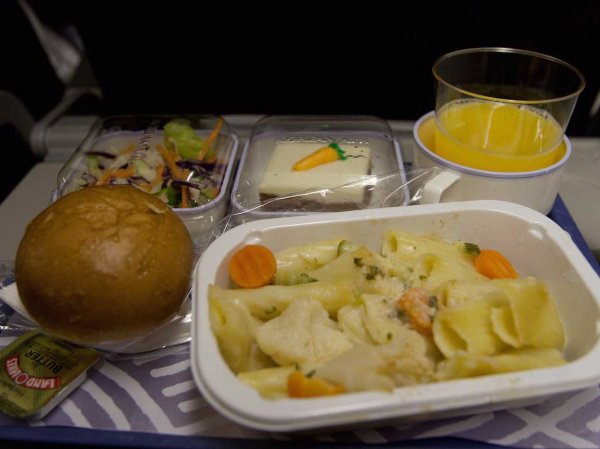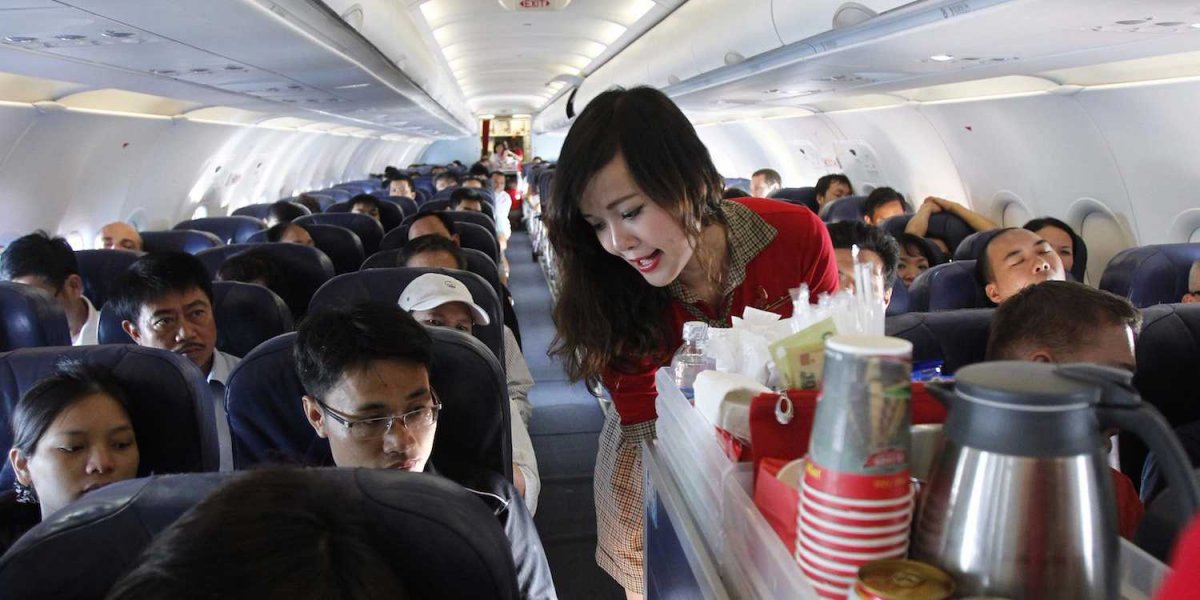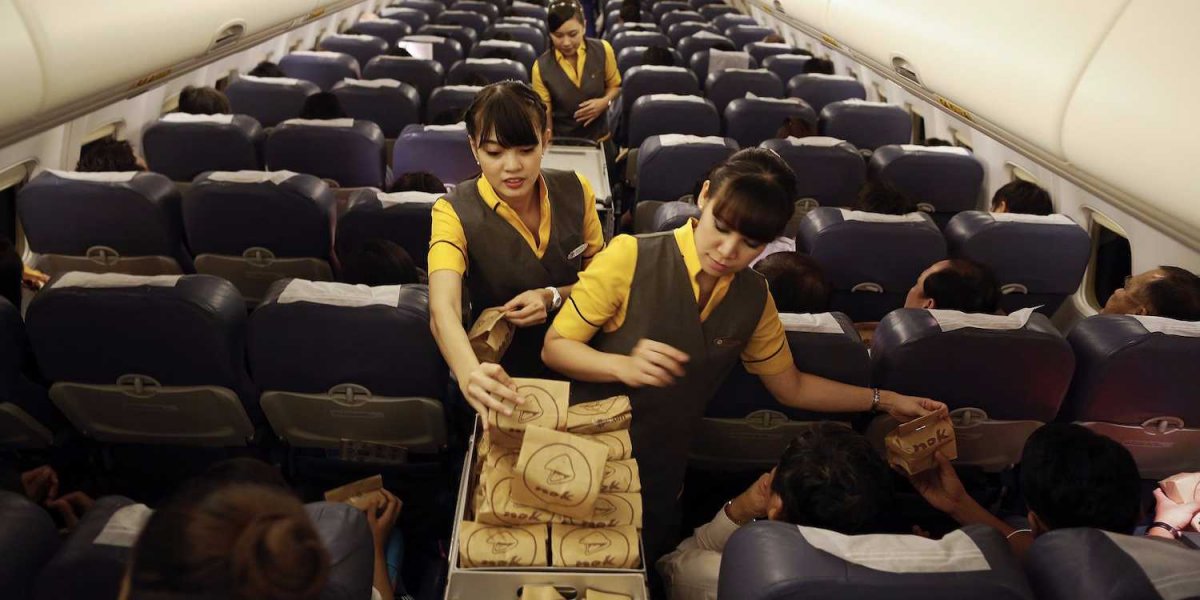Franchising, retail, business

22/03/2015
In the early days of commercial flight, when a transatlantic plane trip could take you 20 hours, there wasn't much to do but read, nap, and eat.
There was no in-flight movie to stare at and try to lip read because you refused to purchase headphones. You could look at the clouds, I guess.
To keep passengers entertained, airlines copied other modes of transportation—trains, boats—and turned to food.
It was not uncommon, in the post-World War II era, to be served a multi-course meal on a flight. A fancy one, too.
We're talking carved roast beef, lobster, prime rib. Real glassware, not those plastic cups filled with those ice cubes that have inexplicable holes that we get now. Airlines were falling all over each other trying to offer special dining experiences to passengers.
"The other entertainment was, of course, to drink," says Guillaume de Syon, a professor of history at Albright College who has researched the history of airline food. "These propeller aircraft were not always very reliable. If [passengers] knew they'd have to land in Reykjavik to have the engine checked, they'd be happy because they knew they could stock up on booze. It was not uncommon to have passengers come off transatlantic flights completely drunk."
As flying got cheaper and easier, these airborne boozehounds soon found themselves with more company in the cabin, and airlines found themselves with more mouths to feed, making that level of fine dining unsustainable.
"It gets more expensive," de Syon says, "flight technology gets better, it gets faster, and you can carry more people. You no longer have the same economies of scale. If you're trying to feed 60 passengers, it's one thing, but the moment you're trying to feed four flights of 150, you have yourself a huge logistical problem."
And thus, in 1952, economy class was born, and with it came a decline in the quality of the food for the masses. While at first airlines tried to compete by continuing to offer special food in economy class, the International Air Transport Association quickly stepped in to regulate what could be offered, to the point of reprimanding an airline for providing an extra roll of bread.
First class fliers, then as now, could still get an elaborate meal, since they paid for the privilege. But their enjoyment of their food likely declined with the advancement of airplane technology as well.
Though old-timey flights were slower and bumpier, when it comes to dining, they had one distinct advantage: The planes weren't pressurized.
Today's planes, which reach altitudes of 35,000 feet or more, are pressurized so you only feel like you're about 6,000 to 8,000 feet above sea level. This helps keep you, you know, breathing at those high altitudes, but it also numbs your taste buds, making food taste blander.
Older aircraft didn't fly as high, meaning the prime cuts of steak being served on those early flights tasted more like they would have on the ground.
Other aspects of the airplane environment make it less than gastronomically ideal—cabin humidity is typically lower than 20 percent (as opposed to the 30 percent or more that is normal in homes), which can dry out your nose, weakening your sense of smell. And smell is inextricably linked to taste. (The dryness of the cabin makes you thirsty, too.)
Also, the air in the cabin is recycled about every two to three minutes. That, plus air conditioning, can dry up and cool down food very quickly, according to de Syon.
"If you were to serve a nice breast of chicken, which you can do on board, within a minute or two, the chicken would be like sawdust," he says.
The solution is in the sauce.
French chef Raymond Oliver is credited with devising this strategy for modern airline food. In 1973, French airline Union de Transports Aériens asked Oliver to design its menu, and he suggested three staple items: beef bourguignon, coq au vin, and veal in a cream sauce.
All of these dishes are covered in sauce, which protects the meat from sawdusting out when reheated and served in the bone-dry environment of an airplane cabin.
This "wetter is better" theory is still largely adhered to, even for meatless dishes. So that takes care of moisture, but the question remains: How best to flavor food so that we might have a chance of tasting it with our papery, lifeless plane-tongues?
Luckily, the Fraunhofer Institute in Germany is on it. They have a "simulated aircraft cabin environment" that is literally the front half of an old Airbus plunked into a low-pressure chamber. Scientists can manipulate the air pressure, humidity, temperature, noise, vibration, and lighting, to make being in the simulator feel just like cruising up in the wild blue yonder, as long as you don't look out the window.
In a paper published in 2010, the institute had a handful of subjects take a simulated flight and tested their ability to smell and taste different flavors. Researchers dissolved the compounds in water, in increasing concentrations, to test how much of a smell or flavor would need to be present before subjects could detect it.
The study found that "at low pressure the detection and recognition thresholds of…odorants are higher," confirming that sense of smell is impaired in the air.
When it came to flavors, the threshold for detecting salty and sweet tastes was much higher in low pressure, while bitter tastes weren't noticeably affected. The threshold for monosodium glutamate (MSG), the additive commonly associated with "the fifth taste," umami (or savoriness), was only slightly higher.
This lends credence to the (only anecdotal) observation that many people seem to order tomato juice (or tomato juice's boozy cousin, the Bloody Mary) on planes. Tomatoes are chock-full of umami, and if their flavor is strong where others' are weak, it stands to reason that they'd be more appealing above the clouds than beneath them.
There's some evidence that planes' white noise, as well as their low pressure, could contribute to reduced taste.
Research has shown that white noise in a non-airplane context suppresses some basic tastes, and considering that, as well as research that shows umami is the most intense of the five tastes, a recent op-ed published in Flavour suggests researching whether umami is a taste that withstands the white noise effect.
The Fraunhofer study recommends that airline caterers spice food more to make it more palatable—curries tend to survive well, and also follow the cardinal rule of wetness. But adding more salt and sugar to meals to make up for the muting of taste buds in the air would make the meals less healthy, and they're already not great for you.
Dr. Charles Platkin, a lecturer at Hunter College and the City University of New York School of Public Health does an annual analysis of the calorie count of foods offered on major airlines. His 2013 analysis found that the average number of calories per food item was 360, down from 388 in 2012, and while some airlines are moving toward healthier food, he says that overall, progress has been slow.
"One of their missions is to increase the tastiness of the food," Platkin says. "But there are so many things popping up [on land] that are focusing on healthy foods, and the airlines generally aren't doing that."
He also notes that making the food taste better could reflect negatively on the airlines in another way.
"Many scientists have found that food directly impacts mood," he says. "When somebody is in the air traveling and they eat a lot of fat and sugar, it affects them in a negative way."
Feeling bad after a salt and sugar-heavy meal, even if it's delicious, could make passengers grumpier about the entire travel experience.
But though food has been an essential part of that experience since passengers first packed themselves into flying metal tubes to get from one place to another, it's becoming increasingly less so. As complimentary meal service disappears from more flights, on anything shorter than an international flight, you're likely to have to make do with peanuts or a sandwich bought for extra off a cart.
De Syon says airlines are shifting from food-as-entertainment to, well, entertainment-as-entertainment. Hence the personalized movie screens on the back of the seat in front of you, and the push to install Wi-Fi on more planes.
While installing these technologies might be a large initial investment, once they're there, passengers are placated with no further effort required. Considering the cost and logistical issues involved in serving food on planes—food the passengers might not even like much of the time—de Syon says it makes sense.
"Passengers are happier spending two hours watching a movie than getting bored of the food, or getting too drunk," he says. "A big problem airlines encounter is that the drunkenness often leads to air rage. [Better to] have them focus on a screen or enjoy themselves on the Internet."
Fonte:http://www.businessinsider.com/why-airplane-food-is-so-bad-2015-3?nr_email_referer=1&utm_source=Sailthru&utm_medium=email&utm_term=Business%20Insider%20Select&utm_campaign=BI%20Select%20Weekend%202015-03-22&utm_content=BISelect&IR=T